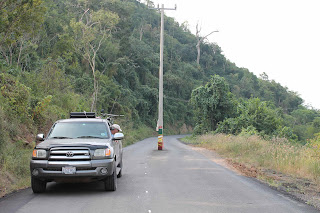Knock on wood, I think I'm going to make it.
I picked up some little respiratory virus on the beach in Mexico at the end of February, which started with a little hacking and wheezing and ended with
a lot of hacking and wheezing, multiple inhalers and a lot of interactions with the medical profession in Mexico, California and New York. And the winner in patient care is......
drum roll, please.....
Mexico. With no runner ups.
If you think that we have the best health care in the world, think again.
My bronchial cough started in the little village of La Manzanilla, and it was simple to walk into Dr. Marta's pharmacy, find out what respiratory virus has been going through the winter population, what to expect, and how to treat it.
No appointment required.
The following week I could feel some some asthma-like symptoms after exercising, so I headed up to another clinic, just up the road from Arroyo Seco. The clinic in Careyes is quite impressive, open until 8 each evening and all night if you pay more. They charge $700 pesos per visit if you're not Mexican (about $52), and the doctor sells you the medicine you need so you don't need to go to another pharmacy. No doubt she has also figured out the profit margin on drugs.
But the point is, medical care was accessible. I was sick, I could go see someone. I could get medications. I could go home feeling a little less anxious about whatever was going on with my lungs.
The following week we were vacationing on the beach in Puerto Vallarta, north of our Mexican vacation home, and my lungs or bronchials still weren't working well. So I could walk into another 24-hour clinic and get a thorough check up, this time getting an additional prescription for a secondary infection. Although I was frustrated that I couldn't shake this thing, I was relieved to be able to get checked out. That clinic charged $40 U.S. and rechecks were free.
Next we traveled back to Sacramento, California, spending a few fun weeks seeing kids and grandkids. Lungs and bronchials were still giving me grief, and I
still couldn't exercise. But now we're back in the states, so I had to make an appointment with my regular physician for the following day (although I only had a $20 co-pay. Although insurance picked up $165 U.S. dollars for that 20 minute visit). A nice bonus with the California system is emailing your physician with questions, although it might be a day before you hear back.
Then home to NY: Because my doctor in New York had moved on from the clinic where we usually go, another doctor was kind enough to see me on an emergency basis. But no calls to or from the clinic after 4 p.m. when the clinic closes for the day. Any minor emergencies, like changes in medication, requires a trip up to the local emergency room. And a lot of dollars.
So from a
patient's perspective, Mexico works a lot better than what I've been experiencing.
In Mexico, doctors usually work from about 9 a.m. until 7 or 8 in the evening, having taken a break between two-hour break for lunch mid-afternoon. So they are available evenings when people often need them.
Many Mexican doctors give you their cell phone number and email addresses so you can ask questions. I don't have to make an appointment, travel to the doctor's office, sit and wait my turn to ask if he or she thinks I can lower a dosage.
A patient friendly system, for me, is to work as a team. They have the knowledge, I have the body and the systems. And often, yes, the anxiety. Our system isn't patient friendly as long as we keep our physicians sequestered and inaccessible.
A minor status detail in Mexico --- the doctors walk in the same front door into the office or clinic as the patients. When is the last time you saw a doctor walk in the same door with you? It definitely discourages casual interaction.
This isn't to blame U.S. doctors. The ones I've seen are great. They've taken their time, they are thoughtful in their approach to treating a persistent problem. I have no doubt that in the current medical system of having too many patients and too little time, they could be inundated and work 24-hours a day trying to be responsive.
But, regardless of whose fault it is, it's pretty bad that when I'm sick, I wish I was back in Mexico for my health care.














